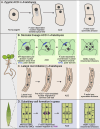The polar code for patterning: how polarity and the cytoskeleton orchestrate asymmetric cell division during plant development
- PMID: 40519265
- PMCID: PMC12162993
- DOI: 10.3389/fcell.2025.1618444
The polar code for patterning: how polarity and the cytoskeleton orchestrate asymmetric cell division during plant development
Abstract
Cell polarity is fundamental to morphogenesis across living organisms. In plants, a dynamic interplay between polarity cues and the cytoskeleton orchestrates essential asymmetric cell divisions across diverse species. Here, we focus on three functions for the cytoskeleton-organelle positioning, cell growth and mitosis-and discuss our current understanding of how polarity controls these processes. By taking a comparative approach that highlights what is known about these pathways across plant species, we spotlight both the broadly conserved and cell type-specific ways that polarity can regulate division orientation. Because there have been significant developments in the field within the last several years, we focus our attention on recent work and give our perspective on exciting future avenues of investigation into the reciprocal relationship between polarity and the cytoskeleton.
Keywords: F-actin; cell division; cytoskeleton; microtubule; plant development; polarity.
Copyright © 2025 Garhewal, Angres and Muroyama.
Conflict of interest statement
The authors declare that the research was conducted in the absence of any commercial or financial relationships that could be construed as a potential conflict of interest.
Figures


Similar articles
-
The Lived Experience of Autistic Adults in Employment: A Systematic Search and Synthesis.Autism Adulthood. 2024 Dec 2;6(4):495-509. doi: 10.1089/aut.2022.0114. eCollection 2024 Dec. Autism Adulthood. 2024. PMID: 40018061 Review.
-
"In a State of Flow": A Qualitative Examination of Autistic Adults' Phenomenological Experiences of Task Immersion.Autism Adulthood. 2024 Sep 16;6(3):362-373. doi: 10.1089/aut.2023.0032. eCollection 2024 Sep. Autism Adulthood. 2024. PMID: 39371355
-
Short-Term Memory Impairment.2024 Jun 8. In: StatPearls [Internet]. Treasure Island (FL): StatPearls Publishing; 2025 Jan–. 2024 Jun 8. In: StatPearls [Internet]. Treasure Island (FL): StatPearls Publishing; 2025 Jan–. PMID: 31424720 Free Books & Documents.
-
Reducing health inequalities through general practice: a realist review and action framework.Health Soc Care Deliv Res. 2024 Mar;12(7):1-104. doi: 10.3310/YTWW7032. Health Soc Care Deliv Res. 2024. PMID: 38551093
-
A Spectrum of Understanding: A Qualitative Exploration of Autistic Adults' Understandings and Perceptions of Friendship(s).Autism Adulthood. 2024 Dec 2;6(4):438-450. doi: 10.1089/aut.2023.0051. eCollection 2024 Dec. Autism Adulthood. 2024. PMID: 40018059
References
Publication types
Grants and funding
LinkOut - more resources
Full Text Sources

